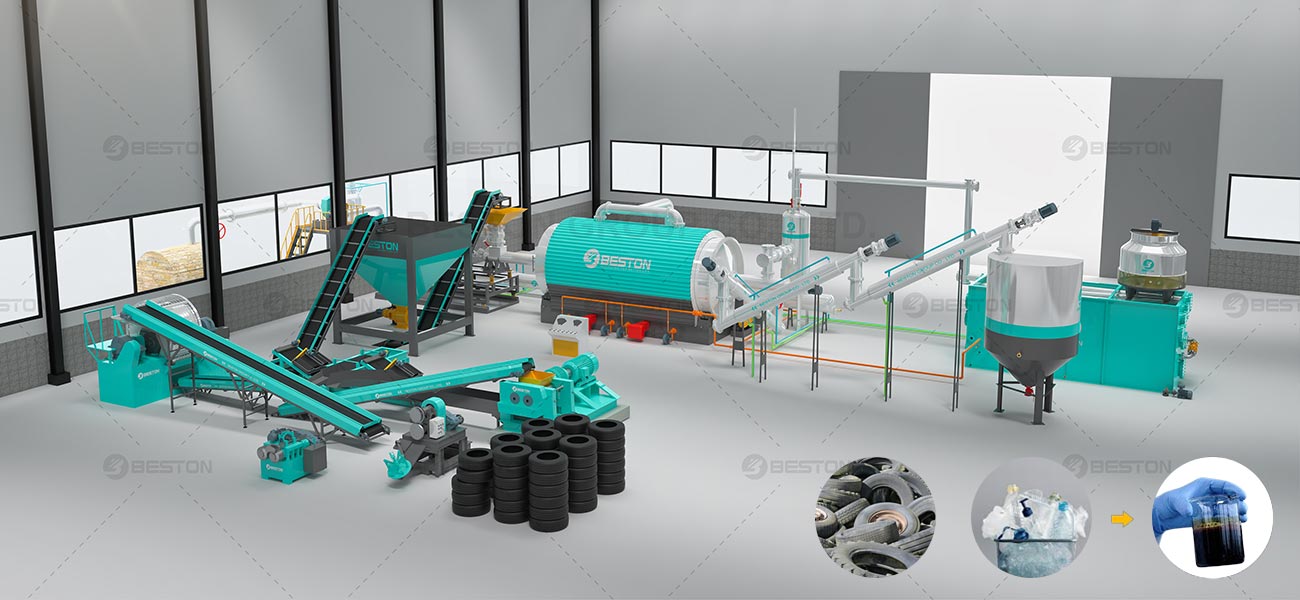Pyrolysis, a thermochemical decomposition process of organic material at elevated temperatures in the absence of oxygen, is gaining significant traction as an environmentally friendly solution to waste management and energy production. This article provides comprehensive reports on three pivotal pyrolysis projects: plastic recycling, tyre recycling, and biomass pyrolysis, examining their technologies, benefits, challenges, and feasibility.
Plastic Recycling Pyrolysis Plant Project Report
Plastic waste is a global environmental challenge, with millions of tons ending up in landfills and oceans annually. A plastic recycling pyrolysis plant addresses this issue by converting plastic waste into valuable resources such as fuel oil, carbon black, and gas.
The plastic recycling pyrolysis process involves shredding plastic waste into smaller pieces, feeding them into a reactor, and heating them in the absence of oxygen. The heat decomposes the plastic into pyrolysis oil (approximately 45-50%), carbon black (30-35%), and combustible gas (10-15%). The pyrolysis oil can be refined into diesel or gasoline, while carbon black and gas are used for industrial applications and energy production. The plastic pyrolysis plant project report has such benefits:
- Environmental Impact: Reduces plastic waste in landfills and oceans, mitigating pollution and wildlife harm.
- Resource Recovery: Converts waste into valuable products, promoting circular economy principles.
- Energy Efficiency: The process generates its own heat from the combustible gases produced, reducing external energy requirements.
The feasibility of a plastic recycling pyrolysis plant depends on several factors: the availability of a consistent plastic waste supply, technological capabilities, market demand for the end products, and supportive regulatory frameworks. With increasing emphasis on sustainability, such projects are becoming more attractive to investors and governments worldwide.
Tyre Recycling Pyrolysis Plant Project Report
Waste tyres pose significant disposal challenges due to their bulk and non-biodegradability. Tyre recycling through pyrolysis offers a sustainable solution, converting tyres into fuel oil, carbon black, steel wire, and gas.
The pyrolysis process for tyres involves shredding them into smaller pieces, removing steel wires, and heating the tyre pieces in a reactor. The breakdown products include pyrolysis oil (40-45%), carbon black (30-35%), steel wire (10-15%), and gas (10-15%). The oil can be used as a heating fuel or refined, while carbon black and steel are valuable industrial materials. The tyre pyrolysis plant project report has such benefits:
- Waste Reduction: Significantly reduces the volume of waste tyres in landfills and incinerators.
- Resource Utilization: Converts waste into commercially valuable products.
- Energy Production: The pyrolysis oil can be used as an alternative fuel, reducing reliance on fossil fuels.
The feasibility of tyre recycling pyrolysis plants hinges on effective feedstock management, technological efficiency, and market conditions for the end products. Regulatory support and incentives for waste management and renewable energy can enhance project viability.

Feasibility Report of Biomass Pyrolysis Project
Biomass pyrolysis converts organic materials like agricultural residues, wood chips, and forestry waste into bio-oil, biochar, and syngas, offering a renewable energy source and soil enhancer.
Biomass pyrolysis involves heating organic material in an oxygen-limited environment. The process produces bio-oil (30-50%), biochar (20-30%), and syngas (20-30%). Bio-oil can be upgraded to biofuels, biochar is used as a soil amendment, and syngas can generate electricity or heat. It has such benefits:
- Renewable Energy: Provides a sustainable energy source, reducing dependency on fossil fuels.
- Carbon Sequestration: Biochar captures carbon, aiding in climate change mitigation.
- Soil Enhancement: Biochar improves soil fertility and water retention, benefiting agricultural productivity.
The feasibility of biomass pyrolysis projects depends on the availability and sustainability of biomass feedstock, technological capabilities, and market demand for bio-oil, biochar, and syngas. Supportive policies, subsidies, and carbon credits can enhance the attractiveness and viability of these projects. https://bestonpyrolysisplant.com/feasibility-report-beston-carbonation-equipment-project/

Conclusion
Pyrolysis projects for plastic recycling, tyre recycling, and biomass conversion present innovative solutions to waste management and energy production. While each project type faces unique challenges, their benefits in terms of environmental impact, resource recovery, and energy efficiency make them promising ventures. Feasibility is influenced by factors such as feedstock availability, technological development, economic viability, and regulatory support. With growing global emphasis on sustainability, these pyrolysis projects are poised to play a crucial role in the transition towards a circular economy and renewable energy future. Welcome to visit Beston Group for more information about pyrolysis plant.